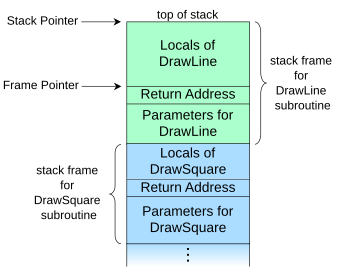Call stack Structure
The stack frame at the top of the stack is for the currently executing routine. The stack frame usually includes at least the following items (in push order):
- the arguments (parameter values) passed to the routine (if any);
- the return address back to the routine's caller (e.g. in the
DrawLinestack frame, an address intoDrawSquare's code); and - space for the local variables of the routine (if any).

Call stack layout
Stack and frame pointers[edit]
When stack frame sizes can differ, such as between different functions or between invocations of a particular function, popping a frame off the stack does not constitute a fixed decrement of the stack pointer. At function return, the stack pointer is instead restored to the frame pointer, the value of the stack pointer just before the function was called. Each stack frame contains a stack pointer to the top of the frame immediately below. The stack pointer is a mutable register shared between all invocations. A frame pointer of a given invocation of a function is a copy of the stack pointer as it was before the function was invoked.[2]
The locations of all other fields in the frame can be defined relative either to the top of the frame, as negative offsets of the stack pointer, or relative to the top of the frame below, as positive offsets of the frame pointer. The location of the frame pointer itself must inherently be defined as a negative offset of the stack pointer.
Storing the address to the caller's frame[edit]
In most systems a stack frame has a field to contain the previous value of the frame pointer register, the value it had while the caller was executing. For example, the stack frame of DrawLine would have a memory location holding the frame pointer value that DrawSquare uses (not shown in the diagram above). The value is saved upon entry to the subroutine and restored upon return. Having such a field in a known location in the stack frame enables code to access each frame successively underneath the currently executing routine's frame, and also allows the routine to easily restore the frame pointer to the caller's frame, just before it returns.
Lexically nested routines[edit]
Programming languages that support nested subroutines also have a field in the call frame that points to the stack frame of the latest activation of the procedure that most closely encapsulates the callee, i.e. the immediate scope of the callee. This is called an access link or static link (as it keeps track of static nesting during dynamic and recursive calls) and provides the routine (as well as any other routines it may invoke) access to the local data of its encapsulating routines at every nesting level. Some architectures, compilers, or optimization cases store one link for each enclosing level (not just the immediately enclosing), so that deeply nested routines that access shallow data do not have to traverse several links; this strategy is often called a "display".[3]
Access links can be optimized away when an inner function does not access any (non-constant) local data in the encapsulation, as is the case with pure functions communicating only via arguments and return values, for example. Some historical computers, such as the Burroughs large systems, had special "display registers" to support nested functions, while compilers for most modern machines (such as the ubiquitous x86) simply reserve a few words on the stack for the pointers, as needed.
Overlap[edit]
For some purposes, the stack frame of a subroutine and that of its caller can be considered to overlap, the overlap consisting of the area where the parameters are passed from the caller to the callee. In some environments, the caller pushes each argument onto the stack, thus extending its stack frame, then invokes the callee. In other environments, the caller has a preallocated area at the top of its stack frame to hold the arguments it supplies to other subroutines it calls. This area is sometimes termed the outgoing arguments area or callout area. Under this approach, the size of the area is calculated by the compiler to be the largest needed by any called subroutine.
Call stack Structure的更多相关文章
- 线性数据结构之栈——Stack
Linear data structures linear structures can be thought of as having two ends, whose items are order ...
- 【LeetCode OJ】Evaluate Reverse Polish Notation
Problem link: http://oj.leetcode.com/problems/evaluate-reverse-polish-notation/ According to the wik ...
- MakeObjectInstance的前世今生(关键是ECX的何时入栈以及Self指针何时存储的)
高手们的文章有很大启发,但是总有些小错,也有没交代清楚的,以下是我的理解: 编译器编译MainWndProc的时候,它是一个正常Delphi普通函数,MakeObjectInstance对它做变换是运 ...
- java建立二叉树,递归/非递归先序遍历,递归/非递归中序遍历,层次遍历
import java.util.LinkedList; import java.util.Scanner; import java.util.Stack; //structure of binary ...
- [转] iOS ABI Function Call Guide
source: apple ARMv6 Function Calling Conventions When functions (routines) call other functions (sub ...
- iOS - Block底层解析
Block是iOS开发中一种比较特殊的数据结构,它可以保存一段代码,在合适的地方再调用,具有语法简介.回调方便.编程思路清晰.执行效率高等优点,受到众多猿猿的喜爱.但是Block在使用过程中,如果对B ...
- allego 输出报告说明
List of Available Reports Assigned Function Report Lists all assigned functions, sorted by function ...
- SECD machine
SECD machine 对程序语言理论的理解 程序语言理论主要研究语法.语义及语言的实现.编程语言有语法,各种数学逻辑.结构化数据都有语法.乔姆斯基的语言体系及巴科斯范式是语法分析的基础,语法分析将 ...
- 【deep learning精华部分】稀疏自编码提取高阶特征、多层微调完全解释及代码逐行详解
我们前面已经讲了如何训练稀疏自编码神经网络,当我们训练好这个神经网络后,当有新的样本输入到这个训练好的稀疏自编码器中后,那么隐藏层各单元的激活值组成的向量就可以代表(因为根据稀疏自编码,我们可以用来恢 ...
随机推荐
- ViewPager学习之仿微信主界面
由于素材的原因,这里都是从网上找的图片,所以所谓的仿微信实际上最后成了下图这货.. .,点击变色也是自己用的windows自带绘图的颜料桶填充的空白. .. watermark/2/text/aHR0 ...
- openstack (1)----- NTP 时间同步服务
一.标准时间 1.地球分为东西十二个区域,共计24个时区 2.格林威治作为全球标准时间即(GMT时间),东时区以格林威治时区进行加,而西时区则进行减 3.地球的轨道并非正圆,在加上自传速度逐年递减,因 ...
- MariaDB -- 数据类型
Mariadb 的数据类型 MariaDB数据类型可以分为数字,日期和时间以及字符串值. 使用数据类型的原则:够用就行, 尽量使用范围小的,而不用大的 常用的数据类型 整数:int, bit 小数:d ...
- HDOJ 5387 Clock 水+模拟
Clock Time Limit: 2000/1000 MS (Java/Others) Memory Limit: 65536/65536 K (Java/Others) Total Subm ...
- 鸟哥的Linux私房菜-----1、Linux是什么与怎样学习Linux
- 嵌入式开发之davinci--- 8127 和8148的区别
1.主要的差别是8148有sata接口,8127没有 2.经过最近各方查找,应该是8107中把DSP砍掉了,8127如1楼所示 http://www.deyisupport.com/question_ ...
- Cocos2d-x编译Android环境
1.Android环境搭配: 下载jdk 下载Android ADT 下载安装Android SDK,地址:http://developer.android.com/sdk/index.html#do ...
- Interval 计时器
语法: setInterval(代码,交互时间); 在执行时,从载入页面后每隔指定的时间执行代码. clearInterval( setInterval() 返回的 ID 值 ): 取消计时器 < ...
- http使用代理
直接上代码: HttpUrlConnection使用代理: private static HttpURLConnection getConnection(URL url, String method, ...
- CF 1042 A Benches —— 二分答案(水题)
题目:http://codeforces.com/problemset/problem/1042/A 代码如下: #include<iostream> #include<cstdio ...
